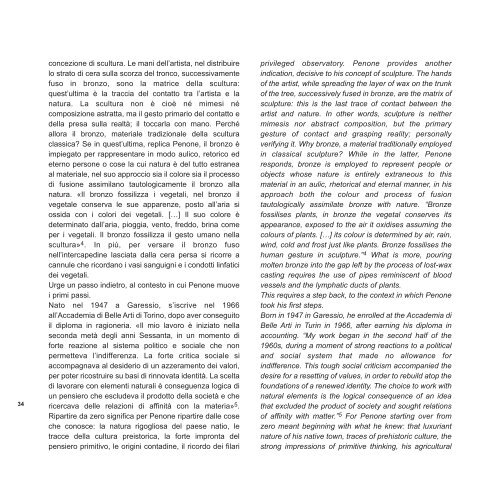Adachiara Zevi - arteinmemoria
Adachiara Zevi - arteinmemoria
Adachiara Zevi - arteinmemoria
Create successful ePaper yourself
Turn your PDF publications into a flip-book with our unique Google optimized e-Paper software.
34<br />
concezione di scultura. Le mani dell’artista, nel distribuire<br />
lo strato di cera sulla scorza del tronco, successivamente<br />
fuso in bronzo, sono la matrice della scultura:<br />
quest’ultima è la traccia del contatto tra l’artista e la<br />
natura. La scultura non è cioè né mimesi né<br />
composizione astratta, ma il gesto primario del contatto e<br />
della presa sulla realtà; il toccarla con mano. Perché<br />
allora il bronzo, materiale tradizionale della scultura<br />
classica? Se in quest’ultima, replica Penone, il bronzo è<br />
impiegato per rappresentare in modo aulico, retorico ed<br />
eterno persone o cose la cui natura è del tutto estranea<br />
al materiale, nel suo approccio sia il colore sia il processo<br />
di fusione assimilano tautologicamente il bronzo alla<br />
natura. «Il bronzo fossilizza i vegetali, nel bronzo il<br />
vegetale conserva le sue apparenze, posto all’aria si<br />
ossida con i colori dei vegetali. […] Il suo colore è<br />
determinato dall’aria, pioggia, vento, freddo, brina come<br />
per i vegetali. Il bronzo fossilizza il gesto umano nella<br />
scultura» 4 . In più, per versare il bronzo fuso<br />
nell’intercapedine lasciata dalla cera persa si ricorre a<br />
cannule che ricordano i vasi sanguigni e i condotti linfatici<br />
dei vegetali.<br />
Urge un passo indietro, al contesto in cui Penone muove<br />
i primi passi.<br />
Nato nel 1947 a Garessio, s’iscrive nel 1966<br />
all’Accademia di Belle Arti di Torino, dopo aver conseguito<br />
il diploma in ragioneria. «Il mio lavoro è iniziato nella<br />
seconda metà degli anni Sessanta, in un momento di<br />
forte reazione al sistema politico e sociale che non<br />
permetteva l’indifferenza. La forte critica sociale si<br />
accompagnava al desiderio di un azzeramento dei valori,<br />
per poter ricostruire su basi di rinnovata identità. La scelta<br />
di lavorare con elementi naturali è conseguenza logica di<br />
un pensiero che escludeva il prodotto della società e che<br />
ricercava delle relazioni di affinità con la materia» 5 .<br />
Ripartire da zero significa per Penone ripartire dalle cose<br />
che conosce: la natura rigogliosa del paese natio, le<br />
tracce della cultura preistorica, la forte impronta del<br />
pensiero primitivo, le origini contadine, il ricordo dei filari<br />
privileged observatory. Penone provides another<br />
indication, decisive to his concept of sculpture. The hands<br />
of the artist, while spreading the layer of wax on the trunk<br />
of the tree, successively fused in bronze, are the matrix of<br />
sculpture: this is the last trace of contact between the<br />
artist and nature. In other words, sculpture is neither<br />
mimesis nor abstract composition, but the primary<br />
gesture of contact and grasping reality; personally<br />
verifying it. Why bronze, a material traditionally employed<br />
in classical sculpture? While in the latter, Penone<br />
responds, bronze is employed to represent people or<br />
objects whose nature is entirely extraneous to this<br />
material in an aulic, rhetorical and eternal manner, in his<br />
approach both the colour and process of fusion<br />
tautologically assimilate bronze with nature. “Bronze<br />
fossilises plants, in bronze the vegetal conserves its<br />
appearance, exposed to the air it oxidises assuming the<br />
colours of plants. […] its colour is determined by air, rain,<br />
wind, cold and frost just like plants. Bronze fossilises the<br />
human gesture in sculpture.” 4 What is more, pouring<br />
molten bronze into the gap left by the process of lost-wax<br />
casting requires the use of pipes reminiscent of blood<br />
vessels and the lymphatic ducts of plants.<br />
This requires a step back, to the context in which Penone<br />
took his first steps.<br />
Born in 1947 in Garessio, he enrolled at the Accademia di<br />
Belle Arti in Turin in 1966, after earning his diploma in<br />
accounting. “My work began in the second half of the<br />
1960s, during a moment of strong reactions to a political<br />
and social system that made no allowance for<br />
indifference. This tough social criticism accompanied the<br />
desire for a resetting of values, in order to rebuild atop the<br />
foundations of a renewed identity. The choice to work with<br />
natural elements is the logical consequence of an idea<br />
that excluded the product of society and sought relations<br />
of affinity with matter.” 5 For Penone starting over from<br />
zero meant beginning with what he knew: that luxuriant<br />
nature of his native town, traces of prehistoric culture, the<br />
strong impressions of primitive thinking, his agricultural


